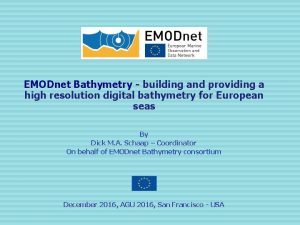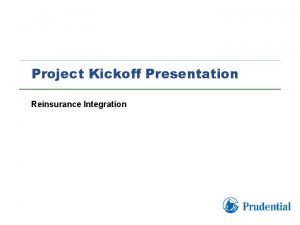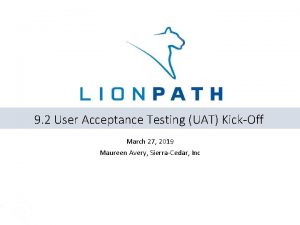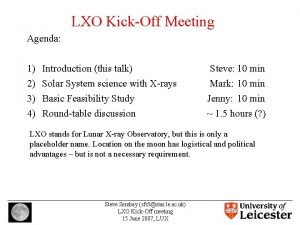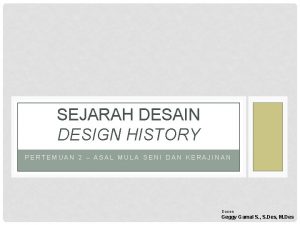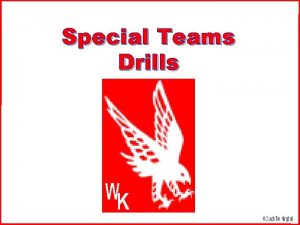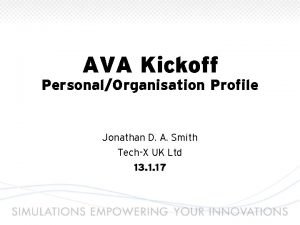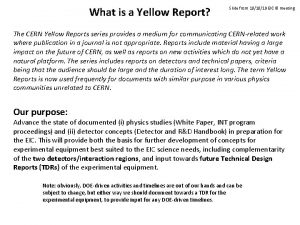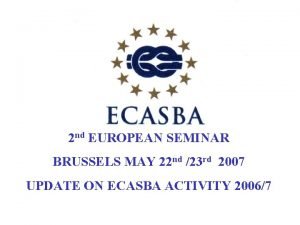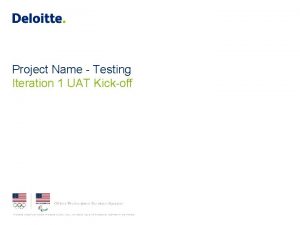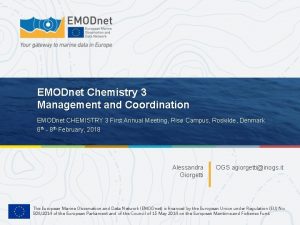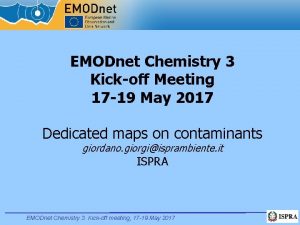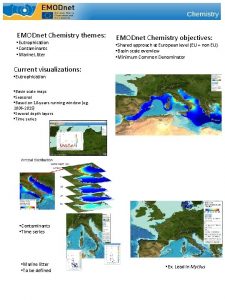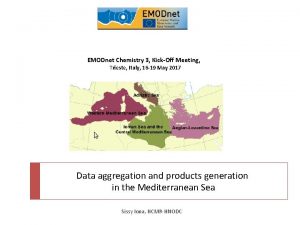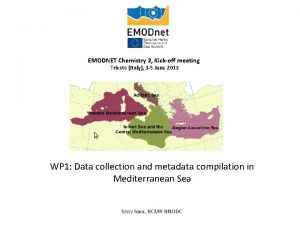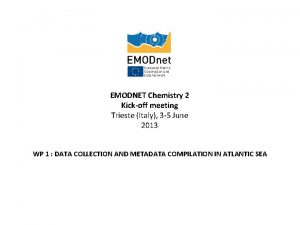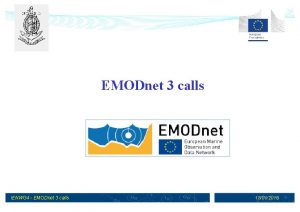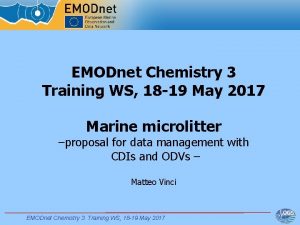EMODnet Chemistry 3 Kickoff Meeting 17 19 May















- Slides: 15

EMODnet Chemistry 3 Kick-off Meeting 17 -19 May 2017 Dedicated maps on contaminants giordano. giorgi@isprambiente. it ISPRA EMODnet Chemistry 3 Kick-off meeting, 17 -19 May 2017

Maps on contaminants General context q Produce specific maps on contaminants that could be a useful tool in environmental impact assessment analysis requested by many EU directives and Regional Sea Conventions agreements. q For a selection of specific contaminants and associated matrix, available data will be quality controlled and validated, and maps will be produced from the validated data. q For such selection the priority substance list extracted from EU Directive 2008/105/EU (EQSD) has been compared with contaminants included in the EMODnet Chemistry tender EMODnet Chemistry 3 Kick-off meeting, 17 -19 May 2017

Maps on contaminants MSFD contaminants GES assessment vs EQSD threshold values From new Revision of Commission Decision on GES: Within coastal and territorial waters, the concentrations of contaminants do not exceed the following threshold values: (a) for contaminants set out under EQSD and River Basin Specific Pollutants, the values set in accordance with Directive 2000/60/EC (i. e. EQSD thresholds); (b) when contaminants under point (a) are measured in a matrix for which no value is set under Directive 2000/60/EC, the concentration of those contaminants in that matrix established by Member States through regional or subregional cooperation; Beyond territorial waters, the concentrations of contaminants do not exceed the following threshold values: (c) for contaminants selected under point (a) of criteria elements, the values as applicable within coastal and territorial waters; (d) for contaminants selected under point (b) of criteria elements, the concentrations for a specified matrix pollution effects. Member States shall establish these concentrations through regional or subregional cooperation. EMODnet Chemistry 3 Kick-off meeting, 17 -19 May 2017

Maps on contaminants MSFD contaminants GES assessment vs EQSD threshold values Contaminants EQSD RBSP Additional Matrix No EQSD thresholds MS thresholds with regional cooperation EMODnet Chemistry 3 Kick-off meeting, 17 -19 May 2017

Maps on contaminants LOQ vs EQSD threshold values From Directive 2009/90/EC: Member States shall ensure that the minimum performance criteria for all methods of analysis applied are based on an uncertainty of measurement of 50 % or below (k= 2) estimated at the level of relevant environmental quality standards and a limit of quantification equal or below a value of 30 % of the relevant environmental quality standards. From EQSD: Where, pursuant to Article 5 of Directive 2009/90/EC, the calculated mean value of a measurement, when carried out using the best available technique not entailing excessive costs, is referred to as ‘less than limit of quantification’, and the limit of quantification of that technique is above the EQS, the result for the substance being measured shall not be considered for the purposes of assessing the overall chemical status of that water body. EMODnet Chemistry 3 Kick-off meeting, 17 -19 May 2017

Maps on contaminants Preliminary list of contaminants included in the proposal : Matrix Water Sediments Biota Contaminants Pesticides and biocides: DDT, HCB Antifoulants: TBT, TPT Heavy metals: Mercury, cadmium, lead Hydrocarbons: Anthracene, Fluoranthene PAH: Benzo(a)pyrene Pesticides and biocides: DDT, HCB Antifoulants: TBT Heavy metals: Mercury, cadmium, lead Hydrocarbons: Anthracene, Naphthalene Pesticides and biocides: Total DDT, HCB Heavy metals: Mercury and its compounds Hydrocarbons: Fluoranthene PAH: Benzo(a)pyrene EMODnet Chemistry 3 Kick-off meeting, 17 -19 May 2017

Maps on contaminants Proposed type of maps a) Above or below LOQ. green points: below LOQ, yellow points: above LOQ b) LOQ above or below EQS threshold values. Green points: LOQ below EQS threshold values, Red points: LOQ above EQS threshold values c) Concentration values above or below EQS threshold values. Green points: concentration values below EQS threshold values, Red points: concentration values above EQS threshold values d) matrix monitored. Blue points: water, Yellow points: sediments, Green points: biota e) species monitored. For ex. Blue points: Mytilus, Yellow points: Oysters, Red points other species. f) For sediments, availability of a normalizer. (TOC or Loss on ignition for organic substances, Li, Al or clay-silt fraction for metals). blue points: normalizer available, yellow points: No normalizer available g) grainsize of the sediment for metals or organic content for organic substances. Scale of colors EMODnet Chemistry 3 Kick-off meeting, 17 -19 May 2017

Maps on contaminants Example: (16) Hexachlorobenzene EQSD threshold values: • maximum allowable concentration (MAC-EQS) in water: 0. 05 μg/l • Biota: 10 μg/kg wet weight From EQSD: Unless otherwise indicated, the biota EQS relate to fish. An alternative biota taxon, or another matrix, may be monitored instead, as long as the EQS applied provides an equivalent level of protection. For substances numbered 15 (Fluoranthene) and 28 (PAHs), the biota EQS refers to crustaceans and molluscs. For the purpose of assessing chemical status, monitoring of Fluoranthene and PAHs in fish is not appropriate. For substance number 37 (Dioxins and dioxin-like compounds), the biota EQS relates to fish, crustaceans and molluscs (…). Which implies: LOQ in water < 0. 3 x 0. 05 μg/l = 0. 015 μg/l LOQ in fish < 0. 3 x 10 μg/kg wet weight = 3 μg/kg wet weight EMODnet Chemistry 3 Kick-off meeting, 17 -19 May 2017

Maps on contaminants Example: (16) Hexachlorobenzene EQSD threshold values: • maximum allowable concentration (MAC-EQS) in water: 0. 05 μg/l • Biota: 10 μg/kg wet weight LOQ in water < 0. 3 x 0. 05 μg/l = 0. 015 μg/l LOQ in fish < 0. 3 x 10 μg/kg wet weight = 3 μg/kg wet weight a) Above or below LOQ. For each point: • if flag=6 then and value is not 0, then Green point • If flag=6 and value is 0, then Yellow point • If flag is not 6 and value is not 0, then Blue point b) LOQ above or below EQS threshold values. For each point with flag=6 and value is not 0: Water: • If value < 0. 015 μg/l, then Green point • If value ≥ 0. 015 μg/l, then Red point Biota (fish): • If value < 3 μg/kg wet weight, then Green point • If value ≥ 3 μg/kg wet weight, then Red point EMODnet Chemistry 3 Kick-off meeting, 17 -19 May 2017

Maps on contaminants Example: (16) Hexachlorobenzene EQSD threshold values: • maximum allowable concentration (MAC-EQS) in water: 0. 05 μg/l • Biota: 10 μg/kg wet weight LOQ in water < 0. 3 x 0. 05 μg/l = 0. 015 μg/l LOQ in fish < 0. 3 x 10 μg/kg wet weight = 3 μg/kg wet weight c) Concentration values above or below EQS threshold values. For each point in water and flag is not 6, take the maximum value and: • If value < 0. 05 μg/l, then Green point • If value ≥ 0. 05 μg/l, then Red point For each point in biota (fish) and flag is not 6: • If value < 10 μg/kg wet, then Green point • If value ≥ 10 μg/kg wet, then Red point EMODnet Chemistry 3 Kick-off meeting, 17 -19 May 2017

Maps on contaminants Example: (16) Hexachlorobenzene EQSD threshold values: • maximum allowable concentration (MAC-EQS) in water: 0. 05 μg/l • Biota: 10 μg/kg wet weight LOQ in water < 0. 3 x 0. 05 μg/l = 0. 015 μg/l LOQ in fish < 0. 3 x 10 μg/kg wet weight = 3 μg/kg wet weight a) matrix monitored. For each point: • If water, then Blue point • If biota is fish, then Green point • If biota is other then fish, then light green point b) species monitored. For each point in biota: • If biota is fish, then Blue points: Mytilus, • If biota is Mytilus, then … • If biota is crustacean, then. . . EMODnet Chemistry 3 Kick-off meeting, 17 -19 May 2017

Maps on contaminants Example: (21) Mercury, (6) Cadmium e) For sediments, availability of a normalizer. For each point in sediment: • If normalizer is available as blue point • If normalizer is not available yellow point f) grainsize of the sediment. For each point in sediment: • If sand (2000 -63 μm), then dark red • If mud (<63 μm), then red • If clay (<2 μm), then orange For (6) Cadmium From EQSD: For Cadmium and its compounds (No 6) the EQS values vary depending on the hardness of the water as specified in five class categories (Class 1: < 40 mg Ca. CO 3 /l, Class 2: 40 to < 50 mg Ca. CO 3 /l, Class 3: 50 to < 100 mg Ca. CO 3 /l, Class 4: 100 to < 200 mg Ca. CO 3 /l and Class 5: ≥ 200 mg Ca. CO 3 /l). • If hardness of the water is available, then green point • If hardness of the water is not available, then red point EMODnet Chemistry 3 Kick-off meeting, 17 -19 May 2017

Work flow for maps on contaminants Inspiration from IFREMER contaminants web portal on French coastal waters: http: //envlit. ifremer. fr/var/envlit/storage/documents/parammaps/contaminan ts-chimiques/ Proposed production workflow in two steps: 1) Harvest of validated monitoring data from EMODNet Chemistry regional leader, then ISPRA could develop maps for 2012 -2018 as shapefile to publish on EMODNet Chemistry portal 2) Dynamic map generated by procedures implemented on EMODNet Chemistry system In any case, maps should be available also as web services (for ex. WFS) to be loaded on GIS desktop platform. EMODnet Chemistry 3 Kick-off meeting, 17 -19 May 2017

Application of maps on contaminants Potential application of maps on contaminants i. Definition of assessment areas, marine reporting units for MSFD and Regional Sea Convention (for ex. Barcellona Convention has just stated to discuss on assessment scale for contaminants) ii. Planning of monitoring programme to focus on knowledge and data gaps to implement Directives (EQSD, …) iii. Assessment tool for contaminants in MSFD and Regional Sea Convention (for ex. Ec. Ap programme) iv. Data layer for EIA - Environmental Impact Assessment procedures for coastal infrastructures EMODnet Chemistry 3 Kick-off meeting, 17 -19 May 2017

Thank You EMODnet Chemistry 3 Kick-off meeting, 17 -19 May 2017
 Emodnet bathymetry download
Emodnet bathymetry download Project kickoff presentation
Project kickoff presentation Uat sign off email template
Uat sign off email template Circle k #45067
Circle k #45067 Proposal kickoff meeting agenda
Proposal kickoff meeting agenda Proposal kickoff meeting agenda
Proposal kickoff meeting agenda Desain kerajinan
Desain kerajinan Mentoring meeting agenda
Mentoring meeting agenda Types of meeting
Types of meeting Today meeting or today's meeting
Today meeting or today's meeting What is meeting and types of meeting
What is meeting and types of meeting Kickoff drills
Kickoff drills Ava's kickoff
Ava's kickoff Kickoff meting
Kickoff meting Fast kickoff training code
Fast kickoff training code Uat kick off meeting
Uat kick off meeting
